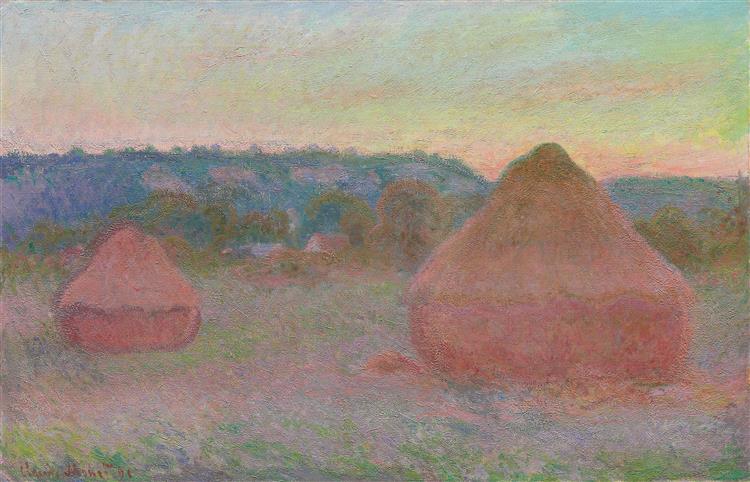Kuvaus
Claude Monet's "Wheat Heaps (End of Day - Autumn)", painted in 1891, represents a masterful culmination of his exploration of landscape painting and his penchant for the shifting effects of light and atmosphere. A pioneer of Impressionism, Monet delves into the depiction of nature and its interaction with light, using this work as a reflection of his constant quest to capture the ephemeral moments that fade before the eye.
Looking at the work, we are greeted by a composition in which the shapes of the wheat stacks dominate the foreground, created with loose, rhythmic brushstrokes that suggest the texture and density of hay. The use of the warm colour palette – hues of gold, orange and a tinge of blue in the sky – evokes a sense of calm and melancholy, typical of the evening hour. In this sense, Monet manages to encapsulate not only the time of day, but also a mood that transcends simple visual representation; the work evokes the transition and passage of time, as well as the cycle of the harvest.
Light plays a fundamental role in this work. Monet, known for his interest in studying light and its effect on objects, uses variations in light in this composition that give the painting an almost musical depth. The shadows projected on the ground and the wheat piles add an air of three-dimensionality and movement, generating a dialogue between the terrestrial space and the sky, which is manifested through clouds that seem to sense the arrival of night.
It is noteworthy that in this work there are no human figures to divert the viewer's attention; the focus remains on man's relationship with nature and agricultural work. However, the absence of characters adds a universal quality to the painting, evoking the silent contemplation of a landscape that has been forged by human hands, but is now presented as a natural element in itself.
"Wheat Heaps" is part of a series of paintings Monet produced between 1890 and 1891, where the harvesting of wheat becomes a recurring theme. This series not only documents an agricultural activity, but is also inserted into a broader context of the industrialization of France. Through these works, Monet establishes a dialogue between the agricultural and the industrial, capturing the impact of both on the landscape. The use of repeated motifs, such as the wheat heaps, allows the viewer to understand Monet's perception of change, abundance, and the inevitable transformation of the natural environment.
Housed at the Art Institute of Chicago, this canvas stands as a testament to Monet’s unique ability to fuse the real and the ephemeral, breathing life into everyday moments. His loose brushstroke technique anticipates the innovations of modern art, and invites us to reflect on the relationship between man and nature, as well as the ceaseless dance of light across the landscape. Ultimately, “Wheat Stacks (End of Day – Autumn)” is not only an aesthetic representation of a moment, but a measure of human experience, where art becomes a channel for the contemplation of what is, and what is to come.
KUADROS ©, a famous painting on your wall.
Hand-made oil painting reproductions, with the quality of professional artists and the distinctive seal of KUADROS ©.
Painting reproduction service with satisfaction guarantee. If you are not completely satisfied with the replica of your painting, we will refund 100% of your money.

